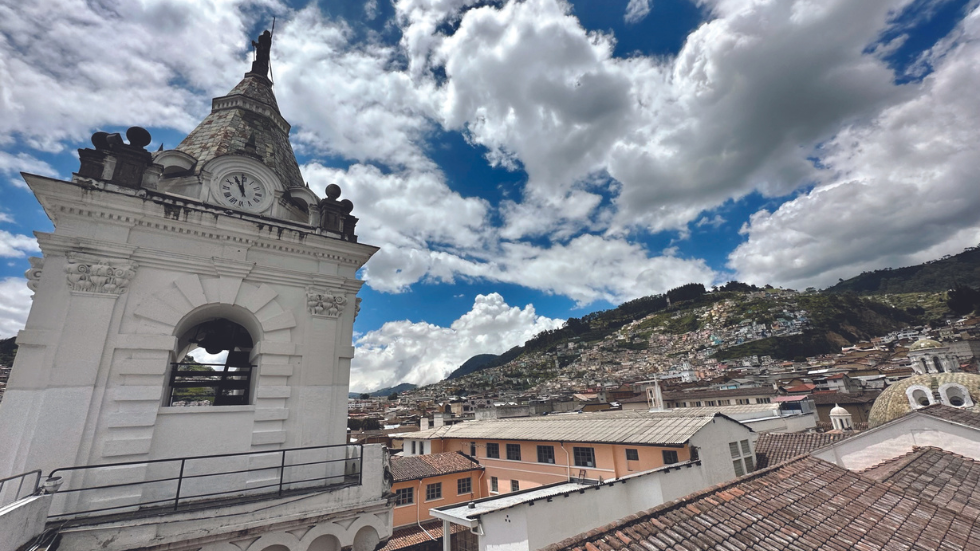Cruising through Nature in the Galápagos Islands
Wildlife abounds on a Galápagos cruise aboard Hurtigruten Expeditions' Santa Cruz II


My head swizzled left to right, front to back, up and down. I didn’t know where to look. To my right, more than a dozen blue-footed boobies roosted on a towering rock face of Isabela Island. A hundred feet below them, barking sea lions lumbered from the rocky shore to the ocean’s edge, contemplating a swim. A Nazca booby, Galápagos hawk and other seabirds soared overhead. And squarely in front of me, a large lava boulder jutting from the water served as a perch for two Galápagos penguins and a host of marine iguanas, their black bodies nearly indistinguishable from the rock but for their heads turning slowly to catch a breeze—or perhaps to wonder at the inflatable boat full of people bobbing on the water.
.png)
The Galápagos penguin is the only penguin species found north of the equator; Photo by Theresa Gawlas Medoff
It was the first full day of my five-day cruise in the Galápagos Islands aboard Hurtigruten Expeditions’ Santa Cruz II, and I was already becoming accustomed to being immersed in nature.
CITY EXPLORATIONS
My journey had begun in Quito, Ecuador, two days before, with a guided full-day tour of the old city. At an elevation of more than 9,000 feet, Quito is the second-highest capital city in the world (following La Paz, Bolivia). It’s hemmed in by the foothills of the Andes and measures just 4 miles wide by 32 miles long.
The UNESCO-recognized historic center of this city of 2.8 million people is known as the largest and best-preserved in Latin America, its cobblestone streets the same that have been trodden for hundreds of years. Some buildings are made of stone, but most are covered with stucco, whitewashed or painted soft shades of ecru, yellow, peach and blue; I spot a dozen or so buildings sporting brightly colored modern murals.
The small-group guided tour that I’m on stops at two ornate Spanish colonial Baroque churches: the Church of San Francisco, fronting the broad pigeon-filled plaza of the same name, which is a gathering spot on Sundays and holidays, and the Church of the Society of Jesus, nicknamed the “gold church” for its over-the-top gold-leaf-covered interior.
The old center of Quito remains the city’s shopping quarter, with traditional food markets, artisan shops and boutiques. At the Market of San Francisco, where vendors sell vegetables, eggs, corn and meats (including guinea pig), we sample a traditional dish of hominy, peas and pork and sip on chicha, my mouth puckering at this sour but popular corn drink that dates back millennia.

Looking above the rooftops of old town Quito to a hillside on the edges of the city; Photo by Teresa Bergen
A few blocks away, we visit with Emma Lagla, a fourth-generation curandera, or healer. “Each plant has its own secret,” she says, waving her hand toward the rows of drying herbs and medicinal plants that line her shop’s walls. At Carrion Restorations, artisan Leonardo Carrion explains how he repairs and restores religious statues. He is a busy man; in a country that’s 80 percent Catholic, most every family has at least one religious statue that’s passed from generation to generation. Our final stop is Sombrerería Benalcázar, a shop that makes hats of wool, felt and straw. Here, we learn the intricacies of hat-wearing in Ecuador, where even the height of the peacock feather in the brim indicates your marital status.
A new friend from my small-group tour and I cap off the day with cocktails at the rooftop bar of Casa Gangotena, a former colonial mansion turned boutique hotel with an enviable location in the heart of town. While sipping signature Fiesta cocktails, we enjoy a sweeping view that takes in the hillside sculpture known as the winged Madonna, with the mist-enshrouded mountains beyond.
ISLAND IMMERSION
The following morning, we fly 800 miles to Baltra, one of 13 major islands that make up the equator-straddling Galápagos Islands. Since departing the dock before lunchtime, we have seen no other humans save for the 28 guests and 57 crew aboard our cruise ship (which has a capacity of 90 guests). The swells of the Pacific Ocean, the clear blue sky and the volcanic islands rich in wildlife become our world.
Most the islands and the waters surrounding them belong to Galápagos National Park and Galápagos Marine Preserve. Only five of the islands are inhabited—and then only a small section of them—with a total population in the islands of 30,000. The park authority controls tourism tightly, and much of the preserved area is accessible only by cruise boat—with cruise lines adhering to strict rotating schedules.
After that morning of coastal exploration on Isabela, the Santa Cruz II pulls up anchor and sails to nearby Fernandina. At about 80,000 years old, these two islands are among the youngest of the Galápagos. This time, we make a wet landing, wading ashore and then hiking across sand and lava fields, sometimes leaping over crevices in the rock.
.png)
A Sally lightfoot crab provides a spot of color amid the marine iguanas gathered on lava rocks; Photo by Theresa Gawlas Medoff
The lava-strewn sections of the shoreline teem with 2- to 4-foot-long marine iguanas so dense that they must clamber over each other to get a more desirable place in the sun. Breaking up this sea of black are bright-orange Sally lightfoot crabs striped with black and yellow. The two species live symbiotically, as the crabs will climb onto the iguanas to snack on parasitic ticks. For their part, the iguanas primarily eat the algae growing on the rocks.
.png)
Sea Lion underwater in Galapagos Ecuador; Photo by Jay Fleming
Sea lions live on Fernandina, too, and we see about two dozen of them—some swimming in the shallows, others snoozing on the beach, a pup nursing at its mother’s teat. A few hundred yards away, two young sea lions play at fighting each other, with a third joining the mock battle.
ABOARD SANTA CRUZ II
Hurtigruten Expeditions is a newcomer in Galápagos tourism. Long known as a premier expedition cruise provider in Norway, the Arctic and other cold-water destinations, it entered the Galápagos cruise market in 2022. The expedition guides aboard our ship, however, are long-time pros in the Galápagos.
My cruise of the Western Galápagos Islands is four nights long, though many of the other passengers stay aboard for another four nights to explore the Northern Galápagos. Hurtigruten also offers six-night cruises of the Eastern Galápagos. Each of the itineraries include two nights in Quito.
My days follow a similar pattern. Breakfast by 8 a.m. after which we gather by 9 a.m. (or earlier) for the morning excursion. Back on the ship after the activity, wet from either seawater or sweat, I shower before heading to the dining room for a three-course lunch the likes of which you’d expect from a AAA Four Diamond restaurant.
An hour or two of downtime for reading, snoozing or perusing the Galápagos-centric library and Science Corner, and then we gather again by mid-afternoon for a second excursion. Because there’s no infrastructure on many of the islands we visit—and no major docks on any of them—we board pangas, rigid inflatable boats with motors, to ferry from the ship to the islands.
We hike, paddle and snorkel our way through our guided island explorations, with naturalist talks each evening in the library followed by cocktails and a run-through of the next day’s agenda. Then we have a leisurely conversation-filled dinner before enjoying the breeze-filled evening on the ship’s deck or simply collapsing into bed.
TOWN AND TORTOISES
When day four dawns, I look out the picture window of my stateroom to see that we’ve dropped anchor again—this time in a bay filled with bobbing ships of various sizes and a small town stretched out behind them. We have arrived at Santa Cruz Island.
.png)
Giant tortoises congregate at a pond in a field on Santa Cruz; Photo by Theresa Gawlas Medoff
Today is the day for giant tortoises, arguably the stars of the Galápagos. In fact, the word Galápagos is derived from an old Spanish word for tortoise. After a brief stop in town, we take a short van ride to the Charles Darwin Research Station, where scientists are studying and breeding giant tortoises to help preserve the species.
Before pirates began to frequent the Galápagos in the 18th century, the islands were home to some 250,000 giant tortoises. The population took a significant hit when seafarers learned that the tortoises, which can weigh up to 600 pounds, are a tasty source of protein—and easy to catch (they typically culled the females, which are significantly smaller than the males). By the 1970s, the number of giant tortoises in the Galápagos had bottomed out at 15,000. Thanks to breeding efforts and strict fines (hit a tortoise with your vehicle—even accidentally—and you’ll 0pay $15,000 and be sentenced to community service), they now number approximately 30,000.
Next, we drive farther inland and make a brief stop at a coffee and sugar cane farm founded 45 years ago by Adriano Cabrera, who demonstrates how he still hand-shells the beans before roasting. I down two cups of the strong brew and buy a large bag of beans to bring home. A mischievous smile on his face, he then brings us to the old wood-fired still where he turns sugar cane into rum. I sample that, too, both straight up and made into a Galápagos cocktail of 60-proof moonshine with sugar cane juice and a squeeze of orange. It packs a wallop.
Fully fueled, we climb aboard the bus again and make a short hop to El Rancho Manzanillo, a livestock ranch, where tortoises are in such abundance that we see them in the fields with the cows and on the sides of the road. We enter an area where tortoises by the hundreds fill the fields and congregate in and around muddy ponds. Enamored with the gentle giants, I take dozens of similar photos, making sure to get myself in a few of them.
.png?h=551&w=980)
Inflatable pangas are best to explore the rugged coastlines and access the islands of the Galápagos; Photo by Theresa Gawlas Medoff
A HUMAN AMID THE FISH
The final full day of the cruise is filled with water-centric excursions. While some paddle-board or kayak, I spend a couple of hours at the beach on Floreana Island. The sun is hot, and I take a cooling dip in the bay. By afternoon, we’re at Champion Islet, one of the best snorkeling spots in the archipelago. Though there’s little coral to be seen, the marine life astonishes me with its variety and abundance: white-tipped reef sharks, green sea turtles and sea lions. I’m thrilled by the larger species of sea life that surround me, but I’m just as intrigued by the smaller ones: porgies, damselfish, grunts, snappers, seabream and thousands of salema. The water is so crystalline that I even see plankton floating in it.
I emerge from the water feeling supremely privileged to have swum among the fishes here in the Galápagos. And when I return to the ship that final evening, I know that I will forever cherish these special days in which I was one of the very few humans among the animals.
